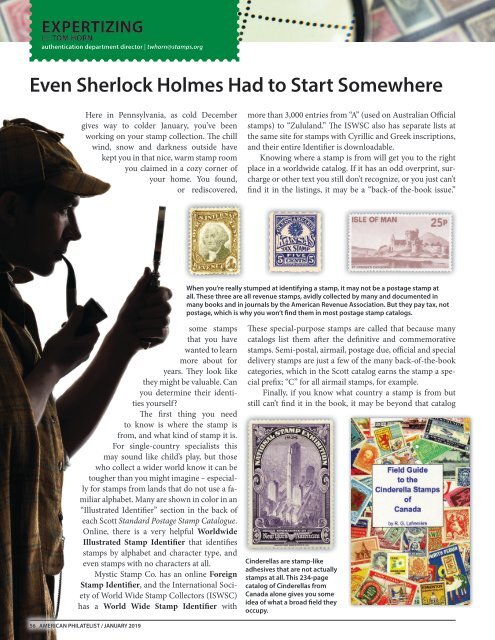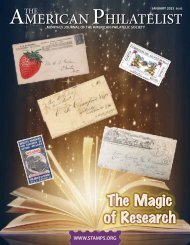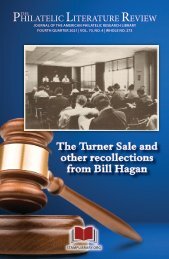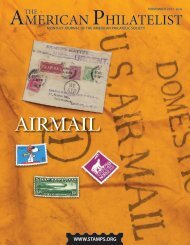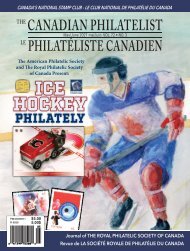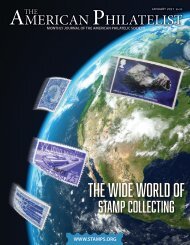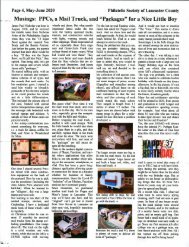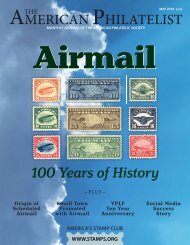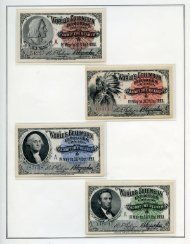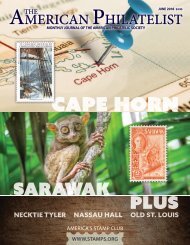January 2019
You also want an ePaper? Increase the reach of your titles
YUMPU automatically turns print PDFs into web optimized ePapers that Google loves.
EXPERTIZING<br />
BY TOM HORN<br />
authentication department director | twhorn@stamps.org<br />
Even Sherlock Holmes Had to Start Somewhere<br />
Here in Pennsylvania, as cold December<br />
gives way to colder <strong>January</strong>, you’ve been<br />
working on your stamp collection. The chill<br />
wind, snow and darkness outside have<br />
kept you in that nice, warm stamp room<br />
you claimed in a cozy corner of<br />
your home. You found,<br />
or rediscovered,<br />
more than 3,000 entries from “A” (used on Australian Official<br />
stamps) to “Zululand.” The ISWSC also has separate lists at<br />
the same site for stamps with Cyrillic and Greek inscriptions,<br />
and their entire Identifier is downloadable.<br />
Knowing where a stamp is from will get you to the right<br />
place in a worldwide catalog. If it has an odd overprint, surcharge<br />
or other text you still don’t recognize, or you just can’t<br />
find it in the listings, it may be a “back-of the-book issue.”<br />
When you’re really stumped at identifying a stamp, it may not be a postage stamp at<br />
all. These three are all revenue stamps, avidly collected by many and documented in<br />
many books and in journals by the American Revenue Association. But they pay tax, not<br />
postage, which is why you won’t find them in most postage stamp catalogs.<br />
some stamps<br />
that you have<br />
wanted to learn<br />
more about for<br />
years. They look like<br />
they might be valuable. Can<br />
you determine their identities<br />
yourself?<br />
The first thing you need<br />
to know is where the stamp is<br />
from, and what kind of stamp it is.<br />
For single-country specialists this<br />
may sound like child’s play, but those<br />
who collect a wider world know it can be<br />
tougher than you might imagine – especially<br />
for stamps from lands that do not use a familiar<br />
alphabet. Many are shown in color in an<br />
“Illustrated Identifier” section in the back of<br />
each Scott Standard Postage Stamp Catalogue.<br />
Online, there is a very helpful Worldwide<br />
Illustrated Stamp Identifier that identifies<br />
stamps by alphabet and character type, and<br />
even stamps with no characters at all.<br />
Mystic Stamp Co. has an online Foreign<br />
Stamp Identifier, and the International Society<br />
of World Wide Stamp Collectors (ISWSC)<br />
has a World Wide Stamp Identifier with<br />
These special-purpose stamps are called that because many<br />
catalogs list them after the definitive and commemorative<br />
stamps. Semi-postal, airmail, postage due, official and special<br />
delivery stamps are just a few of the many back-of-the-book<br />
categories, which in the Scott catalog earns the stamp a special<br />
prefix; “C” for all airmail stamps, for example.<br />
Finally, if you know what country a stamp is from but<br />
still can’t find it in the book, it may be beyond that catalog<br />
Cinderellas are stamp-like<br />
adhesives that are not actually<br />
stamps at all. This 234-page<br />
catalog of Cinderellas from<br />
Canada alone gives you some<br />
idea of what a broad field they<br />
occupy.<br />
56 AMERICAN PHILATELIST / JANUARY <strong>2019</strong>


